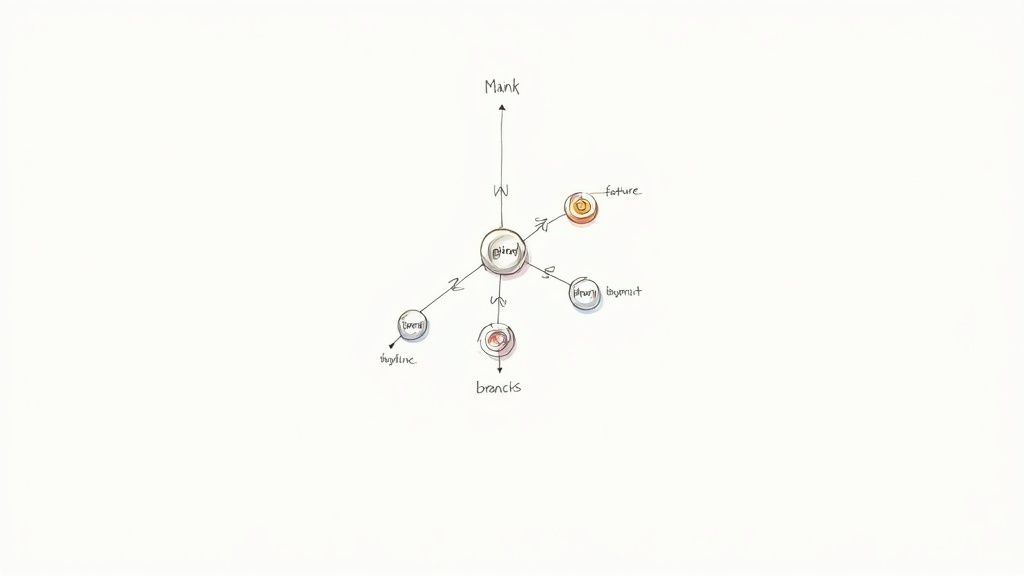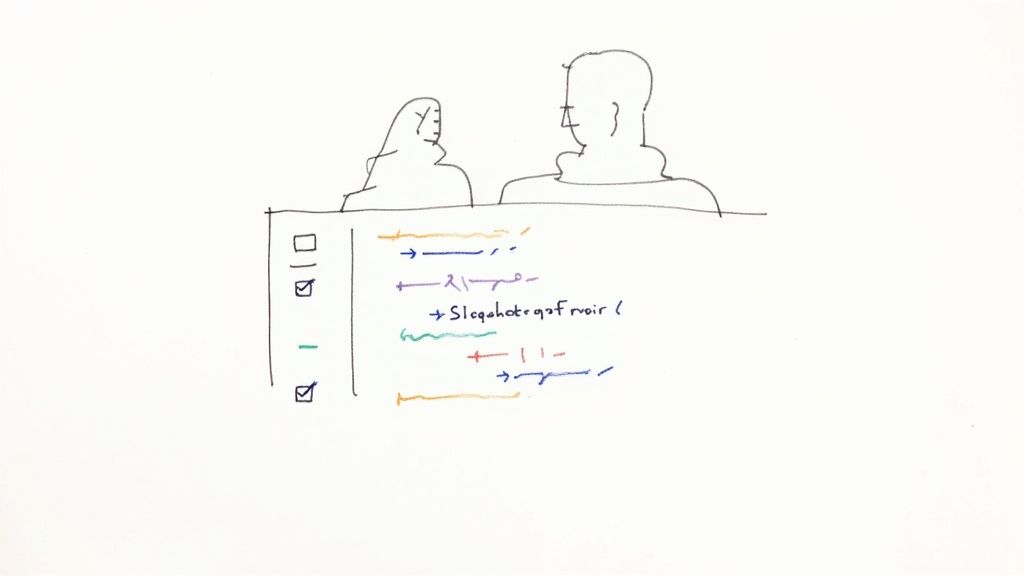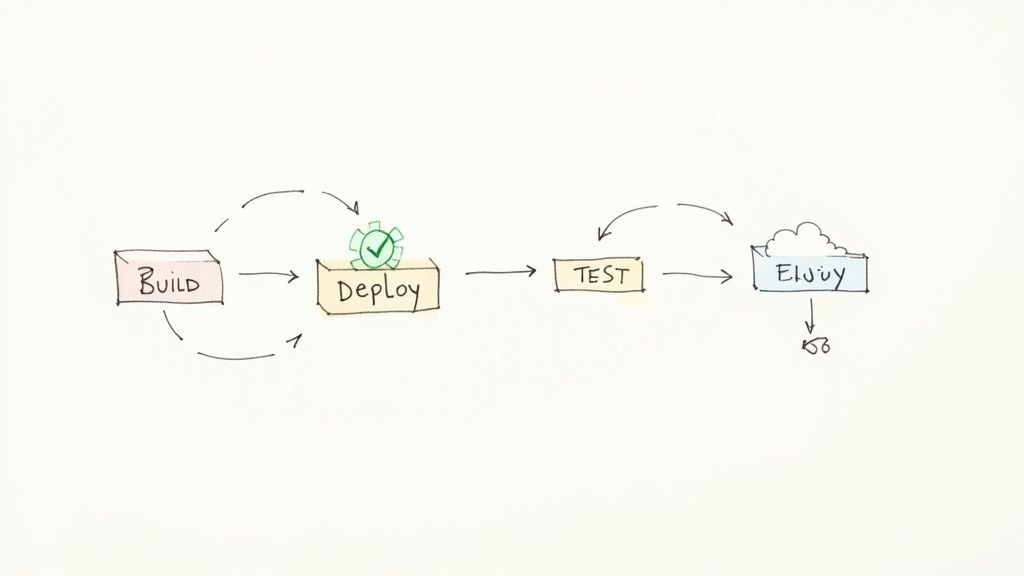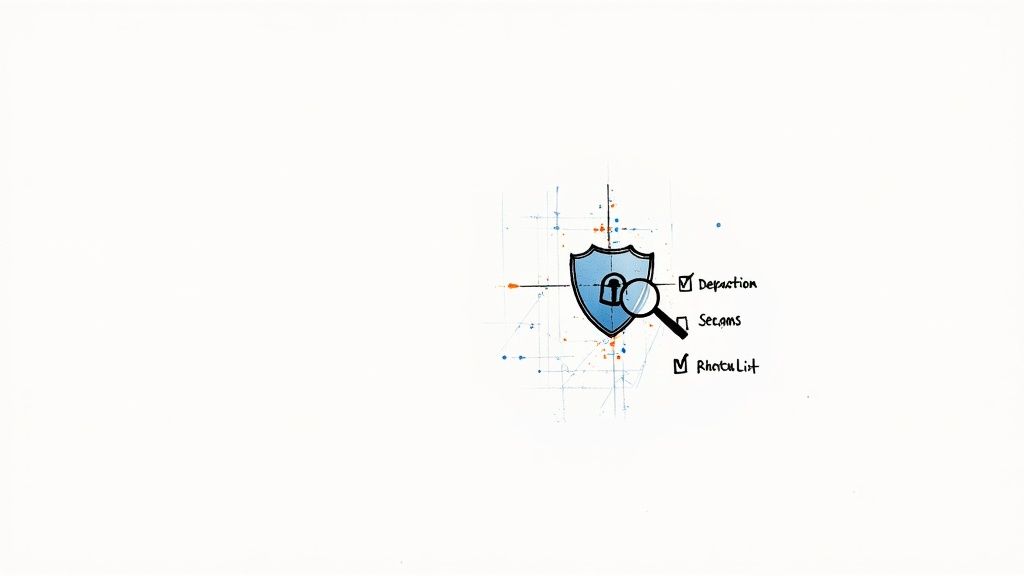Software development best practices for remote teams in 2025
Max
In the world of remote work, the gap between a good software team and a great one often comes down to discipline and shared principles. While talent is crucial, it’s the consistent application of proven methodologies that transforms a distributed group of developers into a high-velocity, cohesive unit. This guide breaks down the most critical software development best practices that empower remote teams to ship reliable, maintainable, and secure code efficiently.
Mastering these practices is non-negotiable for any organization aiming to excel in a remote-first world. From robust version control with Git to proactive security measures, each principle acts as a pillar supporting quality and collaboration across different time zones. We will explore each concept with actionable tips, practical examples, and implementation details tailored for the unique challenges of a distributed engineering environment.
This list is your blueprint for building and scaling elite remote teams. You will learn not just what these practices are, but how to implement them effectively to minimize technical debt, accelerate delivery cycles, and foster a culture of engineering excellence. By adopting these standards, your team can achieve a level of synergy and output that rivals, and often surpasses, that of co-located counterparts.
1. Version Control Systems (VCS)
Version Control Systems (VCS) are the bedrock of modern software development best practices, especially for distributed teams. A VCS like Git allows multiple developers to work on a single codebase simultaneously without overwriting each other’s work. It tracks every change, creating a detailed history that enables teams to review revisions, revert to previous states, and manage different features in parallel through branching.

This systematic approach prevents code conflicts and creates a single source of truth, which is invaluable for asynchronous collaboration. Platforms like GitHub, GitLab, and Bitbucket build upon Git, adding powerful features for code review, issue tracking, and CI/CD automation that are essential for remote teams. Mastering a VCS is non-negotiable for maintaining code integrity and team productivity. For a deeper dive, consider exploring these technical version control best practices to optimize your workflow.
Actionable Tips for Implementation
- Adopt a Branching Strategy: Use a consistent model like GitFlow. Create branches for new features (
feature/user-authentication), bug fixes (bugfix/login-error), and releases to keep your main branch stable. - Write Descriptive Commit Messages: A commit message should explain the what and why of a change, not just the how. A good format is a short summary line followed by a more detailed explanation if needed.
- Commit Small, Logical Chunks: Avoid massive, monolithic commits. Each commit should represent a single, complete logical change, making it easier to review, understand, and revert if necessary. This practice is crucial for effective code collaboration, a key component of the best remote collaboration tools.
2. Code Review
Code review is a cornerstone of effective software development best practices, acting as a critical quality assurance checkpoint. It involves a systematic examination of source code by one or more peers before it is merged into the main codebase. The primary goals are to catch bugs early, improve code quality, ensure adherence to coding standards, and facilitate knowledge sharing across the team. This collaborative process prevents defects from reaching production and mentors developers, fostering a culture of collective ownership and continuous improvement.

This practice is deeply embedded in the workflows of tech giants like Google and Microsoft, as well as in countless open-source projects on GitHub, where peer review is essential for maintaining high standards. By making code reviews a non-negotiable step in the development lifecycle, teams can significantly reduce their technical debt and build more robust, maintainable software. For a more structured approach, consider adopting a framework like the one outlined in Google’s Engineering Practices documentation.
Actionable Tips for Implementation
- Keep Pull Requests Small and Focused: Submit small, self-contained pull requests that address a single concern. This makes reviews faster, easier to understand, and more effective for the reviewer.
- Establish Clear Review Guidelines: Create a checklist or a pull request template that outlines what reviewers should look for, such as code style, test coverage, security vulnerabilities, and logic.
- Provide Constructive, Actionable Feedback: Frame comments as suggestions or questions rather than demands. Focus on the code, not the author, and explain the why behind your feedback to make it a learning opportunity. This is a vital skill for building a strong remote engineering culture.
3. Test-Driven Development (TDD)
Test-Driven Development (TDD) is a core discipline within software development best practices that inverts the traditional coding process. Instead of writing production code first, developers start by writing an automated test case that defines a desired improvement or new function. Naturally, this test fails initially because the code doesn’t exist yet. The developer then writes the minimum amount of code required to make the test pass, after which they can refactor the new code to meet acceptable standards.
This “red-green-refactor” cycle, popularized by Kent Beck, ensures that every piece of code is covered by a test from the moment it’s created. It leads to a more robust, reliable, and maintainable codebase because it forces developers to think about requirements and design before writing code. Companies like Google and Netflix heavily rely on extensive testing cultures, proving TDD’s value in building scalable, high-quality software. It’s a foundational skill for roles that prioritize quality, including those in high demand like remote QA engineer jobs.
Actionable Tips for Implementation
- Follow the Red-Green-Refactor Cycle Strictly: Write a failing test (Red), write just enough code to pass it (Green), and then clean up the code without changing its behavior (Refactor). Don’t skip steps.
- Write One Test at a Time: Focus on a single, small piece of functionality with each test. This keeps the development process focused and makes it easier to pinpoint issues when a test fails.
- Keep Tests Independent and Isolated: Each test should be able to run on its own without depending on others. Use mocking frameworks to isolate external dependencies like databases or APIs.
- Use Descriptive Test Names: A test name should clearly state what it is testing and the expected outcome (e.g.,
test_calculates_total_with_taxortest_throws_error_for_invalid_input).
4. Continuous Integration/Continuous Deployment (CI/CD)
Continuous Integration/Continuous Deployment (CI/CD) is an essential automation framework that revolutionizes how software is delivered. CI focuses on developers merging code changes into a central repository frequently, after which automated builds and tests are run. CD extends this by automatically deploying all code changes that pass the CI stage to a testing or production environment. This practice minimizes manual intervention, enabling teams to deliver value to users faster and more reliably.

Implementing a CI/CD pipeline is a cornerstone of modern software development best practices, allowing companies like Netflix and Amazon to deploy hundreds of changes daily. By automating the build, test, and release cycle, teams reduce integration risks and shorten feedback loops. This automation is managed by tools like Jenkins, GitLab CI/CD, and GitHub Actions, which are central to the work of specialists in remote DevOps jobs.
Actionable Tips for Implementation
- Start with Continuous Integration: Before attempting full continuous deployment, focus on creating a solid CI foundation. Ensure every commit triggers an automated build and a comprehensive test suite to catch bugs early.
- Keep Pipelines Fast: A slow pipeline is a major bottleneck. Aim for build and test cycles under 10 minutes to maintain developer productivity and enable rapid feedback.
- Use Feature Flags for Safe Deployments: Decouple deployment from release. Deploy new features to production behind feature flags, allowing you to turn them on for specific users or disable them instantly if problems arise.
5. Design Patterns
Design patterns are reusable, well-documented solutions to commonly occurring problems within a given context in software design. They are not finished code but rather templates or descriptions of how to solve a problem that can be used in many different situations. This software development best practice, popularized by the “Gang of Four,” provides a shared vocabulary for developers, improving communication and accelerating the development process by offering proven architectural paradigms.
Using patterns like Singleton to ensure a class has only one instance, or the Factory Method to create objects without specifying the exact class, leads to more flexible, reusable, and maintainable code. For instance, the Observer pattern is invaluable for building event-driven systems where multiple objects need to react to a state change without being tightly coupled. Adopting design patterns helps teams build robust, scalable systems by leveraging the collective experience of the software engineering community.
Actionable Tips for Implementation
- Understand the Problem First: Before applying a pattern, ensure you fully understand the problem it solves. Applying a pattern unnecessarily can add needless complexity to your codebase.
- Start with Common Patterns: Begin by learning foundational patterns relevant to your work, such as the Strategy, Decorator, or Adapter patterns, to build a solid understanding before tackling more complex ones.
- Adapt, Don’t Just Copy: A design pattern is a template, not a strict blueprint. Feel free to adapt the pattern’s structure to fit the specific constraints and requirements of your project for optimal results.
6. SOLID Principles
The SOLID principles are a set of five object-oriented design guidelines that are fundamental to modern software development best practices. Coined by Michael Feathers from principles promoted by Robert C. Martin, this acronym stands for Single Responsibility, Open/Closed, Liskov Substitution, Interface Segregation, and Dependency Inversion. Following these principles helps developers create systems that are more understandable, flexible, and maintainable, reducing tight coupling and making code easier to refactor and scale.
Adhering to SOLID is crucial for building robust architectures, especially in complex systems like enterprise applications or microservices where changes are frequent. For instance, the Dependency Inversion Principle is a core concept behind the dependency injection used heavily in frameworks like Spring and Angular. By creating decoupled components, teams can work on different parts of an application independently, a significant advantage for distributed remote teams. For an in-depth exploration, Robert C. Martin’s “Clean Architecture” is an excellent resource.
Actionable Tips for Implementation
- Keep Classes Focused: Ensure each class has only one reason to change (Single Responsibility Principle). If a class manages user data and sends emails, split it into two separate, more cohesive classes.
- Use Interfaces for Abstraction: Design components to depend on abstractions (interfaces) rather than concrete implementations. This makes it easier to swap out components, such as changing a payment gateway, without altering the core business logic.
- Leverage Dependency Injection: Actively use dependency injection frameworks or patterns to manage dependencies. This practice directly supports the Dependency Inversion Principle, leading to more modular and testable code.
7. Documentation and Comments
Comprehensive documentation and meaningful comments are essential for code comprehension and maintenance in remote teams. Inline comments help explain the why behind complex logic, while API documentation, architecture guides, and README files provide a high-level project overview. Adopting standards like Python’s PEP 257 docstrings, Java’s Javadoc annotations, or JSDoc in JavaScript ensures consistency across languages and frameworks.
Well-documented code reduces onboarding time, prevents knowledge loss when developers rotate off projects, and supports seamless collaboration across time zones. Tools such as Swagger or OpenAPI can generate interactive API docs directly from annotations, while clear architecture documents and sample code snippets in READMEs guide contributors through setup and usage. For a deeper dive, explore this comprehensive documentation guide. This practice solidifies software development best practices by creating a reliable knowledge base for future work.
Actionable Tips for Implementation
- Write comments explaining the why, not the what, and keep them close to the related code.
- Use self-documenting code conventions—clear naming plus PEP 257, Javadoc or JSDoc standards.
- Generate and version-control API docs automatically with Swagger or OpenAPI annotations.
- Maintain a comprehensive README with project overview, setup steps, and usage examples.
- Update documentation alongside code changes to prevent drift and ensure accuracy.
8. Agile Development Methodology
The Agile Development Methodology is an iterative approach to project management and software development that helps teams deliver value to their customers faster and with fewer headaches. Instead of a rigid, sequential “waterfall” process, Agile breaks down large projects into small, manageable increments called sprints. This framework prioritizes flexibility, customer collaboration, and rapid response to change, making it one of the most vital software development best practices for dynamic environments.
Agile methodologies, such as Scrum or Kanban, empower teams to adapt to evolving requirements and stakeholder feedback throughout the development lifecycle. This continuous loop of planning, executing, and evaluating ensures the final product truly meets user needs. Companies like Spotify and Google have famously leveraged Agile principles to foster innovation and maintain a competitive edge, proving its effectiveness at scale. For remote teams, an Agile mindset is particularly beneficial, as it promotes constant communication and transparency.
Actionable Tips for Implementation
- Start with a Clear Framework: If you are new to Agile, adopt a well-defined framework like Scrum. It provides a structured approach with clear roles (Product Owner, Scrum Master), events (Daily Standup, Sprint Retrospective), and artifacts (Product Backlog) to guide your team.
- Keep Sprints Short and Focused: Aim for sprint lengths of one to four weeks. Each sprint should have a clear, achievable goal that delivers a tangible piece of working software. This creates momentum and provides frequent opportunities for feedback.
- Prioritize Effective Communication: Use daily stand-ups to keep everyone aligned on progress and roadblocks. This is especially critical for distributed teams, where structured communication is key. Mastering these interactions is one of the core best practices for remote teams.
9. DRY Principle (Don’t Repeat Yourself)
The DRY (Don’t Repeat Yourself) principle is a fundamental concept in software development best practices, asserting that “every piece of knowledge must have a single, unambiguous, authoritative representation within a system.” Popularized by Andy Hunt and Dave Thomas in The Pragmatic Programmer, its core goal is to reduce code duplication. By abstracting common logic into reusable functions, classes, or modules, you create a single source of truth.
This approach significantly improves maintainability. When a change is needed, you only have to update the logic in one place, which reduces the risk of introducing bugs from inconsistent implementations across duplicated code blocks. For instance, instead of writing the same data validation logic in multiple API endpoints, you can extract it into a shared utility function. This not only cleans up the codebase but also ensures that any future validation rule changes are applied universally and consistently.
Actionable Tips for Implementation
- Follow the Rule of Three: Avoid premature abstraction. It’s often better to wait until you see the same code block repeated three times before refactoring it into a reusable component.
- Create Helper and Utility Libraries: Group common, non-domain-specific functions (like string manipulation or date formatting) into a central, well-documented utility library that any part of the application can access.
- Use Configuration Files for Constants: Instead of hardcoding values like API keys, database connection strings, or feature flags in multiple places, store them in a single configuration file. This makes updates simple and error-proof.
10. Refactoring
Refactoring is a disciplined software development best practice for restructuring existing computer code without changing its external behavior. Popularized by experts like Martin Fowler, this process is essential for improving code quality, reducing complexity, and enhancing maintainability over time. It systematically cleans up the internal structure, making the codebase easier to understand, modify, and extend in the future. By proactively managing technical debt, teams prevent the slow degradation of their software’s architecture.
This strategic process is not about fixing bugs or adding new features; it’s about improving the design after it has been written. For example, a large, unwieldy method can be broken down into several smaller, more focused functions (Extract Method), or complex conditional logic can be simplified by replacing it with polymorphism. These incremental improvements make the code more resilient and adaptable, which is critical for long-term project success and developer productivity.
Actionable Tips for Implementation
- Refactor in Small, Safe Steps: Never attempt a large-scale refactoring in one go. Make small, incremental changes and run tests after each one to ensure you haven’t broken anything.
- Have a Safety Net: Before you begin, ensure you have a comprehensive suite of automated tests. These tests act as a safety net, verifying that the code’s behavior remains unchanged after your improvements.
- Separate Refactoring from Feature Development: Do not mix refactoring with adding new functionality in the same commit. This practice keeps changes isolated, making them easier to review, understand, and revert if necessary.
11. Security Best Practices
Security best practices encompass techniques and principles for building secure software from design through deployment. They integrate threat modeling, secure coding, dependency management, authentication, encryption, input validation and regular security audits across the development lifecycle. This approach ensures vulnerabilities are caught early and reduces costly post-release fixes.

Adopting a proactive security mindset aligns with DevSecOps principles and frameworks such as OWASP, NIST or Microsoft SDL. Tools like GitHub security scanning, OWASP Dependency Check, SonarQube, HashiCorp Vault and AWS IAM automate checks and enforce policies. You can also formalize policies by referencing a comprehensive Secure Software Development Policy to integrate security throughout your workflow.
Security best practices deserve their place in the list because they protect brand reputation and ensure compliance with data protection regulations. Embedding security reduces time spent on bug fixes and boosts customer trust.
Learn more about Security Best Practices on remotefirstjobs.com
Actionable Tips for Implementation
- Use threat modeling in design phase to map attack surfaces.
- Implement least privilege for services and users with IAM roles.
- Keep dependencies updated and scan for known vulnerabilities in CI pipelines.
- Validate and sanitize all user inputs to prevent SQL injection.
- Enforce HTTPS and strong encryption for data in transit and at rest.
- Manage secrets with tools like HashiCorp Vault or AWS Secrets Manager.
- Integrate security scanning tools like SonarQube or OWASP checks.
- Implement secure logging policies to avoid exposing sensitive data.
12. Performance Optimization and Monitoring
Performance optimization and monitoring are critical software development best practices for delivering a high-quality user experience. This dual approach involves proactively identifying and eliminating bottlenecks to improve speed and resource efficiency, while continuously tracking key metrics to prevent degradation. A performant application directly impacts user satisfaction and business outcomes, as demonstrated by Amazon’s focus on sub-100ms latency to boost conversions.
Neglecting performance can lead to slow load times, high operational costs, and a poor reputation. By integrating monitoring from the start, teams can establish performance baselines and catch issues before they affect users. This continuous loop of measuring, optimizing, and monitoring ensures the application remains fast, scalable, and reliable under real-world load conditions, which is essential for maintaining a competitive edge.
Actionable Tips for Implementation
- Profile Before Optimizing: Don’t guess where bottlenecks are. Use profiling tools to identify the exact functions or queries consuming the most time and resources, often following the 80⁄20 rule where 80% of issues lie in 20% of the code.
- Set a Performance Budget: Define clear, measurable performance goals before development begins. For example, set a maximum load time of 2 seconds or a specific server response time limit. This holds the team accountable for performance throughout the lifecycle.
- Focus on User-Centric Metrics: Monitor metrics that directly impact the user experience, such as First Contentful Paint (FCP), Time to Interactive (TTI), and API response times. These provide a more accurate picture of perceived performance than just CPU usage.
12-Point Software Development Best Practices Comparison
| Item | 🔄 Implementation Complexity | ⚡ Resource / Time Requirements | ⭐ Expected Effectiveness | 📊 Ideal Use Cases / Impact | 💡 Key Advantages / Tips |
|---|---|---|---|---|---|
| Version Control Systems (VCS) | 🔄 Moderate — simple setup, branching/merge discipline needed | ⚡ Low infrastructure; some storage/hosting and training | ⭐⭐⭐⭐ — essential for collaboration & history | 📊 Team development, branching workflows, open-source projects | 💡 Use clear commits, .gitignore, branch protection |
| Code Review | 🔄 Low–Moderate — process and cultural setup | ⚡ Moderate — reviewer time; tooling lightweight | ⭐⭐⭐⭐ — improves quality and knowledge sharing | 📊 Pre-merge validation, mentoring, consistency enforcement | 💡 Keep PRs small, automate linters, set review SLAs |
| Test-Driven Development (TDD) | 🔄 High — test-first discipline and workflow changes | ⚡ Higher upfront dev time; ongoing test maintenance | ⭐⭐⭐⭐ — strong defect reduction & better design | 📊 Critical logic, libraries, systems requiring reliability | 💡 Write small independent tests; refactor often; aim ~80% coverage |
| Continuous Integration / Continuous Deployment (CI/CD) | 🔄 High — pipeline design, infra and process complexity | ⚡ High infra and maintenance; needs robust test suites | ⭐⭐⭐⭐⭐ — enables frequent, reliable releases | 📊 High-deploy-frequency orgs, microservices, fast feedback loops | 💡 Start with CI, keep pipelines fast, use feature flags and monitoring |
| Design Patterns | 🔄 Medium — conceptual learning and correct application | ⚡ Low runtime cost; dev time to apply patterns | ⭐⭐⭐ — improves maintainability when applied correctly | 📊 Architectural problems, reusable solutions, cross-team communication | 💡 Learn GoF patterns, avoid over-engineering, adapt to context |
| SOLID Principles | 🔄 Medium — requires design discipline and abstraction | ⚡ Moderate — extra abstractions and DI but low infra cost | ⭐⭐⭐⭐ — promotes maintainable, testable, extensible code | 📊 OO systems, long-lived codebases, modular architectures | 💡 Apply incrementally; balance with pragmatism; use DI where useful |
| Documentation and Comments | 🔄 Low — writing process; upkeep discipline required | ⚡ Moderate ongoing effort; automation helps (docs-as-code) | ⭐⭐⭐ — aids onboarding and maintenance if current | 📊 APIs, libraries, onboarding, knowledge transfer | 💡 Document “why” not “what”; keep docs versioned and updated |
| Agile Development Methodology | 🔄 Medium–High — cultural/process adoption and change | ⚡ Variable — requires roles, ceremonies, continuous engagement | ⭐⭐⭐⭐ — improves adaptability and time-to-market | 📊 Product development with evolving requirements | 💡 Start with Scrum, keep clear sprint goals, involve product owner |
| DRY Principle (Don’t Repeat Yourself) | 🔄 Low–Moderate — conceptual; risk of premature abstraction | ⚡ Low — developer time for refactoring and design | ⭐⭐⭐ — reduces duplication and maintenance effort | 📊 Repeated logic, shared configuration, utility code | 💡 Apply after spotting repetition; follow rule of three to avoid premature DRY |
| Refactoring | 🔄 Medium — requires tests and careful incremental changes | ⚡ Time-consuming; needs test coverage and reviewer time | ⭐⭐⭐⭐ — reduces technical debt and improves clarity | 📊 Legacy cleanup, complexity reduction, pre-release improvements | 💡 Refactor in small steps, ensure tests, use IDE tools |
| Security Best Practices | 🔄 High — spans design, code, infra, and processes | ⚡ Significant investment in expertise, tools, and audits | ⭐⭐⭐⭐⭐ — critical for preventing breaches and meeting compliance | 📊 Customer-facing apps, regulated industries, sensitive data systems | 💡 Do threat modeling early, use least-privilege, scan dependencies in CI |
| Performance Optimization & Monitoring | 🔄 Medium–High — profiling expertise and continuous work | ⚡ Moderate–High — monitoring costs and engineering effort | ⭐⭐⭐⭐ — improves UX, scalability, and reduces costs | 📊 High-traffic services, SLAs, real-time systems | 💡 Measure before optimizing, set performance budgets, monitor continuously |
Turning Principles into Practice for Remote Success
Navigating the landscape of modern software development, especially within a remote-first environment, requires more than just technical skill. It demands a commitment to a shared set of principles that foster collaboration, ensure quality, and promote sustainable growth. The practices we’ve explored, from the foundational git-flow discipline of Version Control to the proactive quality gate of Test-Driven Development, are not isolated tactics. They are interconnected pillars that support a culture of engineering excellence.
For distributed teams, these software development best practices are the very fabric of effective collaboration. Rigorous code reviews become your virtual whiteboard sessions, and a well-oiled CI/CD pipeline acts as your team’s automated quality assurance specialist. Adhering to SOLID principles and the DRY mantra ensures that codebases remain intelligible and maintainable, even when contributors are separated by continents and time zones. This disciplined approach minimizes friction, reduces ambiguity, and empowers developers to build with confidence and autonomy.
Your Actionable Path Forward
Moving from theory to application is the most critical step. Rather than attempting a complete overhaul overnight, focus on incremental adoption. Here are some concrete next steps your team can take:
- Start with One Thing: If your team isn’t doing code reviews, start there. If your test coverage is low, introduce a policy for writing tests for all new features. Pick one practice and focus on integrating it into your workflow until it becomes second nature.
- Automate What You Can: The power of CI/CD cannot be overstated. Begin by automating your testing and build processes. This single step will save countless hours, reduce human error, and provide immediate feedback loops, which are invaluable for remote teams.
- Establish Clear Standards: Document everything. Create a clear, accessible guide for your coding standards, security protocols, and documentation expectations. A shared understanding is the bedrock of consistency and quality, preventing minor misalignments from escalating into major technical debt.
Ultimately, mastering these software development best practices is a continuous journey, not a final destination. It’s about cultivating a mindset of continuous improvement, where every commit, every review, and every deployment is an opportunity to refine your craft and elevate your product. By embedding these principles into your daily operations, your remote team can build software that is not just functional but also scalable, secure, and resilient, truly harnessing the power of distributed talent to achieve exceptional results.
Ready to apply these high-level skills in a company that values engineering excellence? Explore thousands of vetted remote developer roles on Remote First Jobs. We connect talented developers with forward-thinking companies that have built their culture around these very best practices. Find your next great opportunity at Remote First Jobs today.


